
If you’re exploring Osaka and Kyoto, food should be at the top of your list.
These two cities are home to some of Japan’s most iconic dishes, from sizzling okonomiyaki and crispy kushikatsu to melt-in-your-mouth sushi and hearty ramen.
Here are 12 places where you can taste the best local flavors and enjoy meals that you simply can’t miss. 😊
1. Okonomiyaki at Mizuno (Osaka)
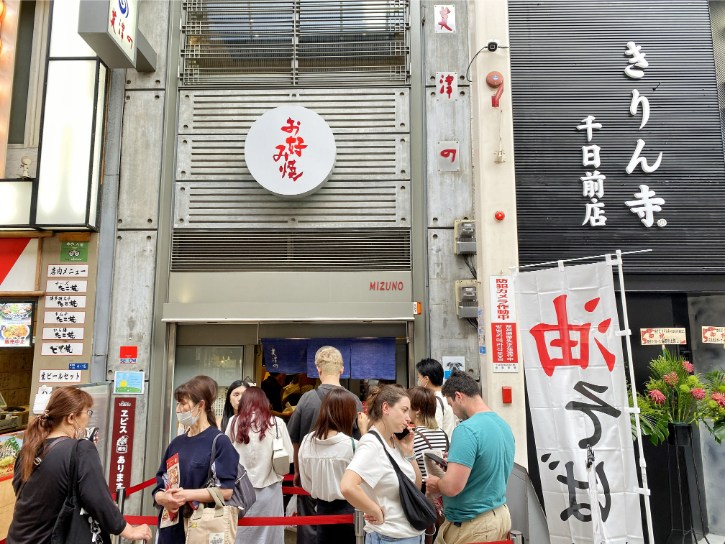
You can’t leave Osaka without trying okonomiyaki, and Mizuno is the place to do it.
This legendary shop in Dotonbori has been serving savory pancakes for over 75 years.
Three generations of the same family have kept the tradition alive, and it shows in every bite.
What makes Mizuno special is their fluffy yam batter. It creates a creamy inside that pairs perfectly with rich toppings like pork belly, shrimp, and scallops.
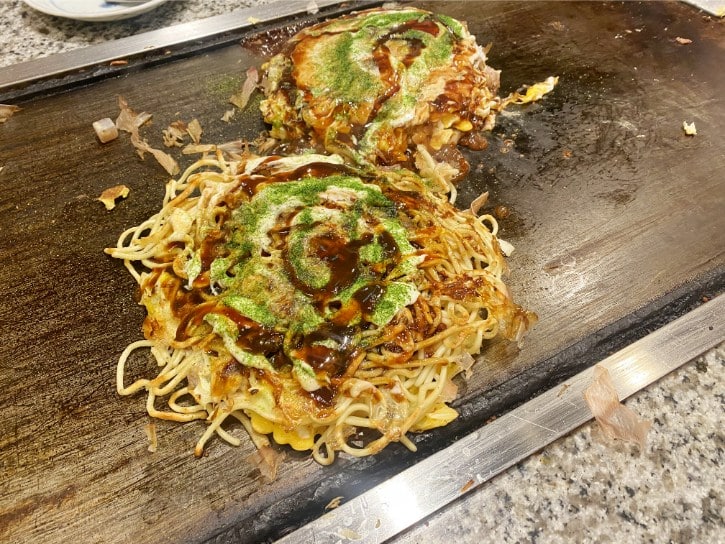
The Michelin Guide recognized them in their Bib Gourmand section, so you know the quality is real.
Try the Yamaimo-yaki if you want something unique. It’s made only with grated yam and no flour, making it extra fluffy and soft.
You can pick two toppings for around ¥1,900 to ¥2,100 ($13 to $14).
The Mizuno-yaki is their house special with six different toppings including pork, beef, squid, shrimp, scallops, and octopus. In winter, they swap one ingredient for oysters.
Sitting at the counter watching your okonomiyaki cook on the teppan grill is half the fun.
Expect to spend about ¥1,500 to ¥2,500 ($10 to $17) per person for a filling meal.
Location: Google Maps
2. Takoyaki at Wanaka Dotonbori (Osaka)
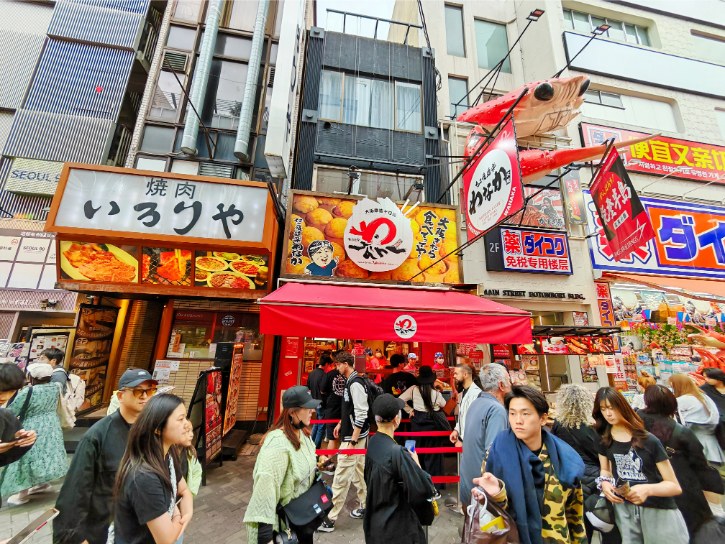
Takoyaki is Osaka’s most famous street food, and Wanaka makes the best version.
These octopus-filled batter balls are always fresh because of the constant crowds. You’ll often see lines, but they move quickly.
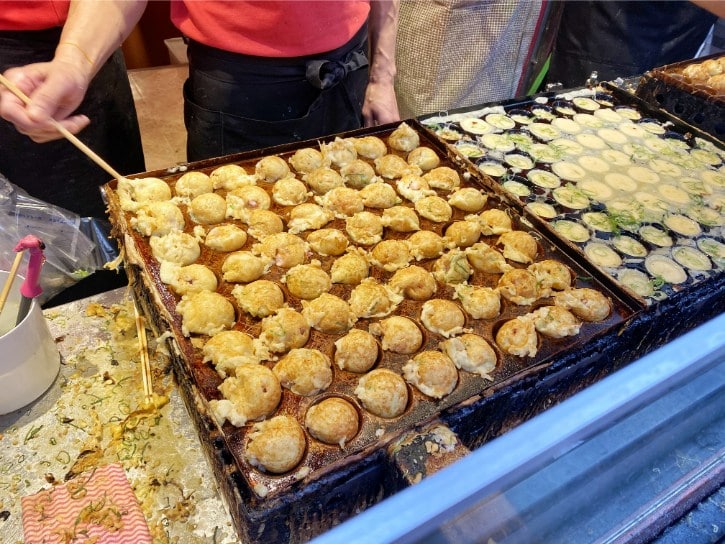
Each golden ball has a crispy outside and creamy inside with a chewy piece of octopus in the center.
They’re topped with tangy-sweet sauce, Japanese mayo, green seaweed flakes, and bonito shavings that dance in the heat.
The combination creates layers of umami flavor that hit different parts of your tongue.
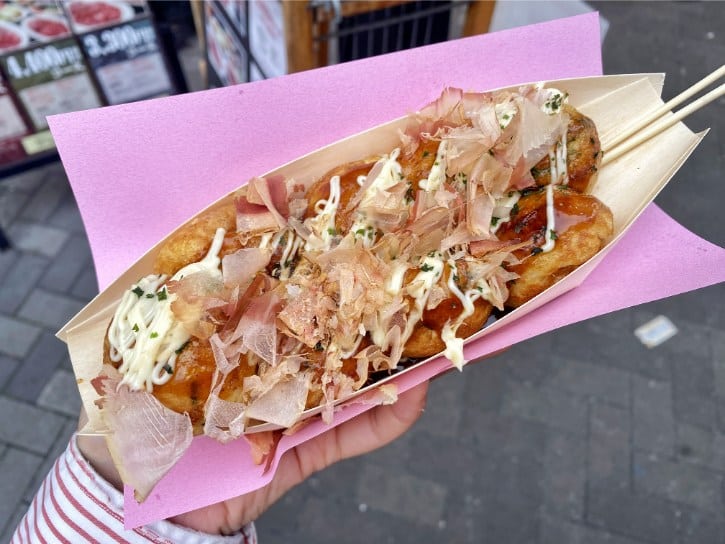
Be careful when you first bite in. The inside is piping hot and can burn your tongue. Let them cool for a few seconds first.
The Original Takoyaki is what you came for. Eight pieces cost around ¥650 to ¥800 ($4 to $5).
If you want variety, try the Ooiri Variety Box with four different styles including soy sauce with bonito, classic sauce, salt style, and mentai mayo.
The Takosen is fun too. It’s a takoyaki ball sandwiched between two crispy rice crackers.
You can easily try takoyaki for ¥300 to ¥800 ($2 to $5), making it the perfect snack while exploring Dotonbori.
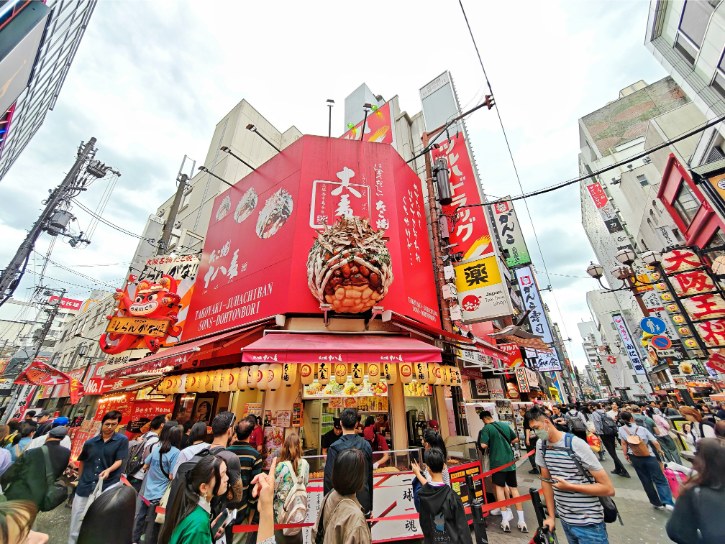
Another takoyaki shop worth trying is Takoyaki Juhachiban Dotonbori if you want to compare different styles.
Location: Google Maps
Read More: 17 Best Street Foods to Try in Dotonbori Osaka
3. Ramen at Hanamaruken Hozenji (Osaka)
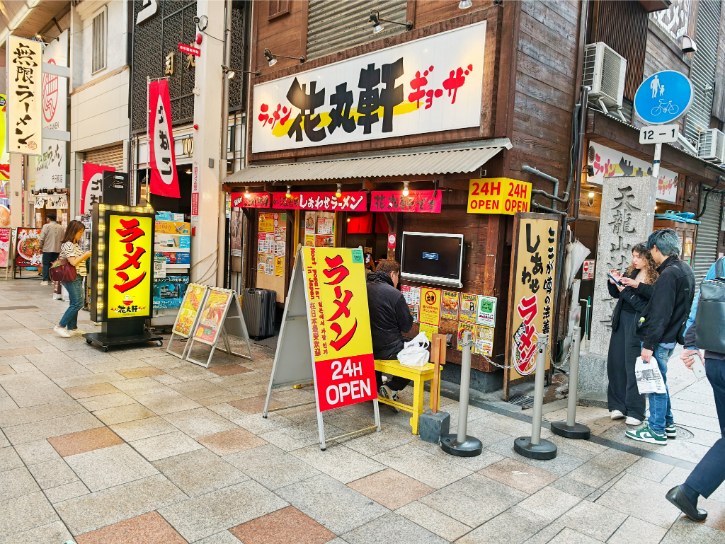
Osaka ramen is different from what you might know from other cities.
Hanamaruken serves a rich, pork-based soup with a soy-leaning profile that’s bold and satisfying. The broth is deep and meaty but not too heavy.

Their signature item is the slow-cooked pork rib. It’s so tender it falls apart when you touch it with chopsticks.
The thick, chewy noodles hold up well against the rich broth and stay firm to the last bite.
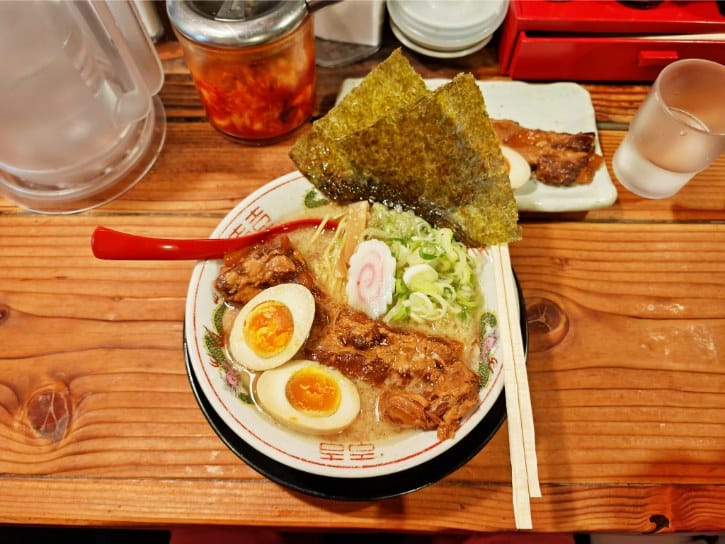
The MANZOKU combo is perfect if you’re really hungry. For ¥1,880 ($12), you get ramen plus extra sides that make it a complete meal.
The half pork rib rice bowl and ramen egg combo is popular too at ¥1,580 ($11).
If you want something lighter, try the omelette fried rice combo for ¥1,480 ($10).
A basic ramen bowl runs about ¥900 to ¥1,050 ($6 to $7). The sets range from ¥980 to ¥1,880 ($6 to $12) depending on what sides you add.
Location: Google Maps
4. Sushi at Daiki-suisan Kaitenzushi (Osaka)
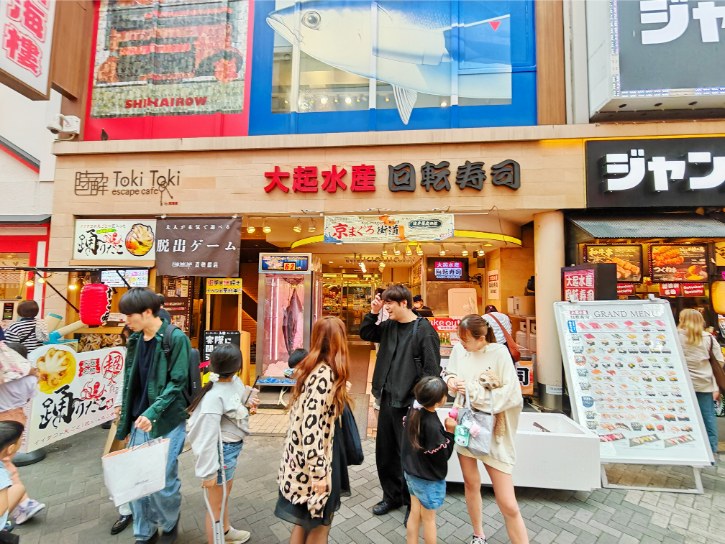
This conveyor-belt sushi restaurant in Dotonbori is run by a major seafood wholesaler, which means the fish quality is consistently excellent.
Besides Dotonbori, Daiki-suisan has shops in Tennoji, Umeda, Namba, and near Osaka Castle.
The big draw here is the daily whole tuna cutting show. Chefs carve a massive bluefin tuna right in front of customers, and those cuts go straight to plates.
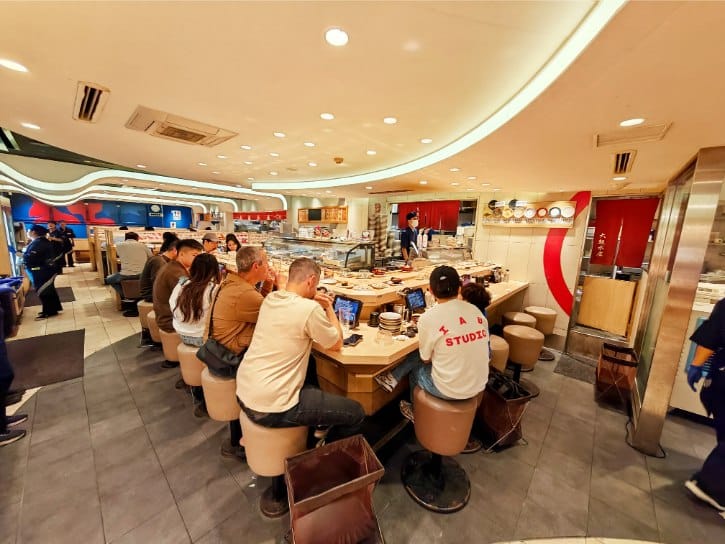
The fatty bluefin tuna is the star. It’s so rich and buttery it literally melts on your tongue.
Even if you’re not usually a raw fish person, this might convert you. The salmon belly is creamy and a favorite among locals who eat here often.
Sweet shrimp is plump and naturally sweet. For something adventurous, try the Hokkaido uni (Sea Urchin) with its custard-like texture.

You can grab plates from the conveyor belt or order specific items from the touch panel.
Most plates start around ¥100 to ¥150 ($0.70 to $1), with premium items like fatty tuna or uni (Sea Urchin) costing ¥400 to ¥800 ($3 to $6).
Plan to spend about ¥1,500 to ¥3,000 ($10 to $20) per person for a satisfying meal.
It’s much cheaper than upscale sushi restaurants but the quality is surprisingly good.
Location: Google Maps
5. Sushi at Kura Sushi Shinsekai (Osaka)
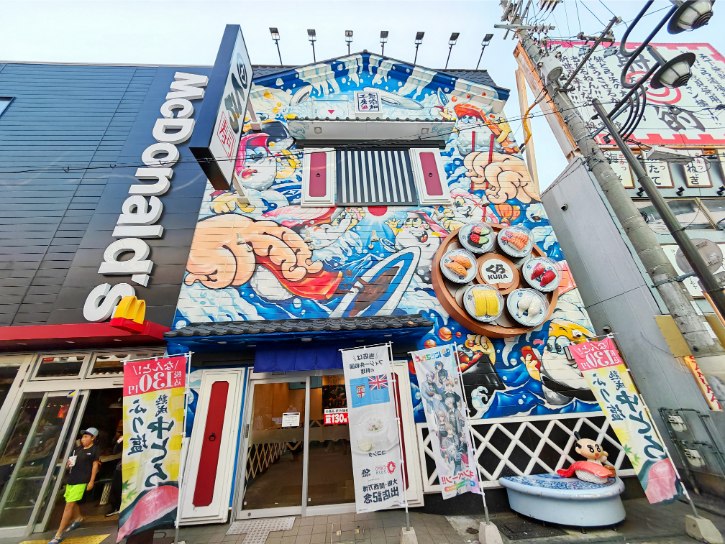
If you want to try sushi without spending much, Kura Sushi is perfect.
You’ll find Kura Sushi in popular areas like Namba, Dotonbori, Umeda, and Tennoji, but the Shinsekai Tsutenkaku branch is worth visiting if you’re exploring the tower and Shinsekai’s retro streets.
This location near Tsutenkaku Tower has a colorful cartoon sushi mural that makes it easy to spot.
Most plates cost just ¥115 ($0.80), so you can sample many different types.
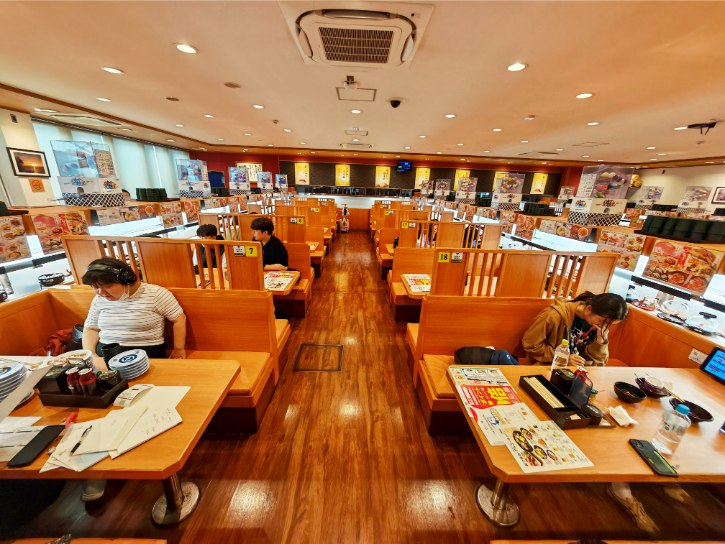
The interactive element is part of the fun. When you order from the tablet, your sushi zooms directly to your seat on a high-speed lane. It feels like the future of dining.
The quality is better than you’d expect for the price. Try the basic maguro tuna for clean, meaty flavor, or upgrade to fatty tuna if it’s available.
The salmon is buttery and smooth. The seared salmon comes with sauce or mayo that adds smoky and creamy notes.
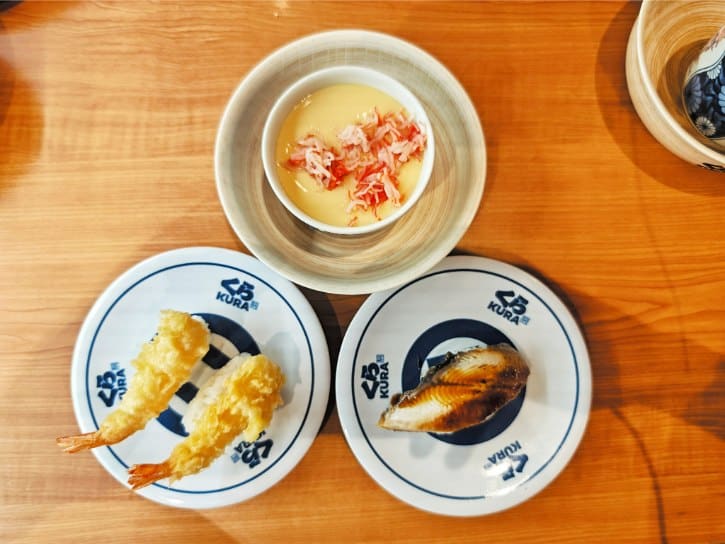
Don’t skip the unagi grilled eel. It’s usually expensive elsewhere, but here you can try it cheaply.
The scallop with mentaiko gunkan mixes chopped scallops with spicy cod roe mayo. It’s creamy, briny, and a little spicy.
The shrimp tempura sushi features crunchy fried shrimp laid over sushi rice, often with a touch of sauce.
They also serve hot dishes like udon, ramen, fried chicken, and takoyaki if you need a break from raw fish.
If you eat 8 to 15 plates, expect to spend ¥1,000 to ¥1,800 ($7 to $13 USD).
Location: Google Maps
6. Kushikatsu at Daruma (Osaka)
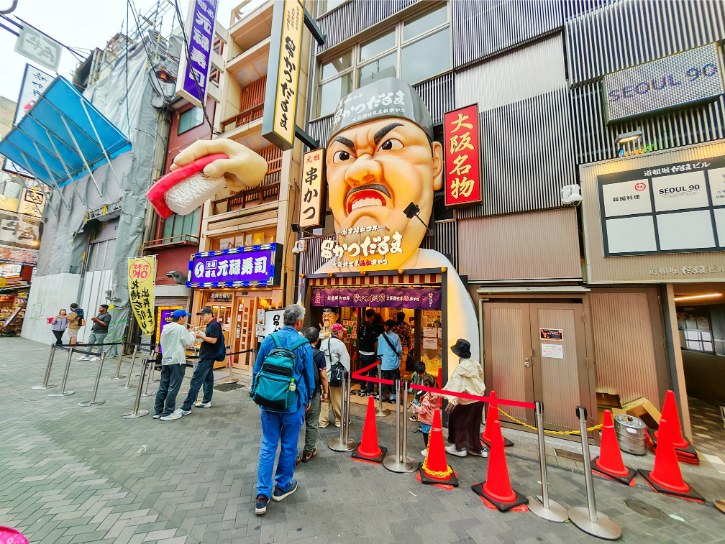
Kushikatsu is deep-fried skewers covered in light, crispy breadcrumbs.
Daruma has been making them since 1929, and they know what they’re doing.
First opened in Shinsekai, they now have branches in Dotonbori and other parts of Osaka.
You’ll recognize the shop by the angry chef statue outside and the famous rule: no double-dipping in the communal sauce.
The batter is light and never too oily. Each skewer gets dipped in Daruma’s special sweet-tangy sauce that enhances the flavors without overpowering them.
You get free cabbage with every order to refresh your palate and scoop extra sauce.
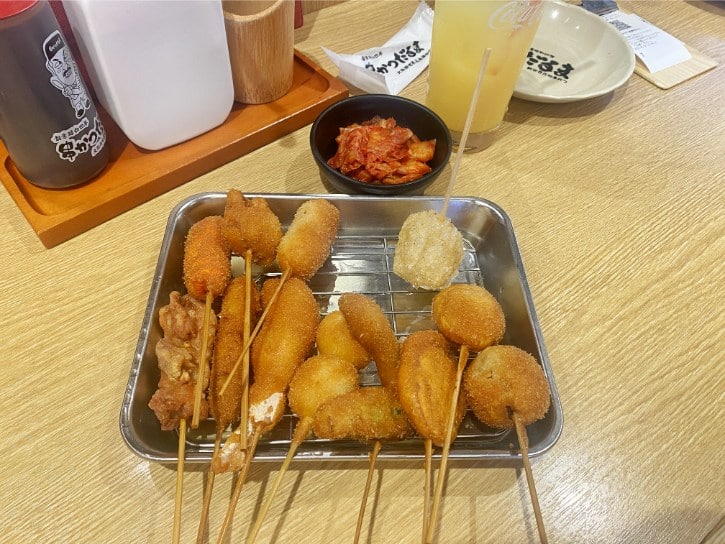
The variety keeps things interesting. You might try beef and shrimp next to cheese, rice cakes, and seasonal items like oysters.
Using cabbage leaves to scoop sauce instead of double-dipping your skewer is part of the local dining culture.
The Combo Janjan gives you nine skewers for ¥1,760 ($12), including beef, shrimp, quail egg, asparagus, rice cake, pork cutlet, sausage, fish sausage with cheese, and chicken meatball.
The Combo Doubutenmae has 18 different skewers for ¥2,695 ($18) if you want to try everything.
Individual skewers cost ¥140 to ¥200 ($1 to $1.50) each. Most people spend ¥1,500 to ¥2,500 ($10 to $17) for a meal.
Location: Google Maps
Read More: The Perfect 3-Day Osaka Itinerary
7. Gyukatsu at Kyoto Katsugyu (Kyoto)

Most people know tonkatsu pork cutlets, but gyukatsu beef cutlets are less common and worth trying.
Kyoto Katsugyu specializes in beef with a crispy panko crust and juicy medium-rare center.
Started in Kyoto in 2014, they now have shops across Japan, including Kyoto (Gion, Kyoto Station, Kawaramachi), Osaka (Namba, Umeda), and Tokyo (Shinjuku, Shibuya, Akihabara).
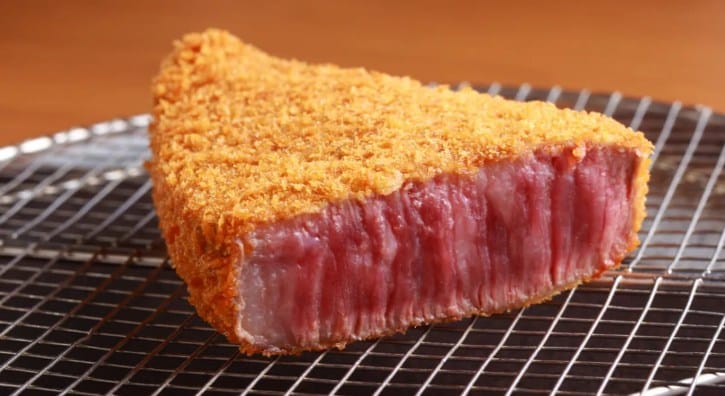
The beef is quickly fried, keeping it tender while adding crunch.
What makes this special is all the ways you can eat it. Try it with wasabi and dashi soy sauce for a fresh kick.
The gyukatsu sauce with sesame is rich and slightly sweet. Sansho pepper salt gives it a citrusy, tingling finish from Kyoto spices.
The onsen egg mixed with dashi soy sauce creates a creamy dip that coats the beef perfectly. If you like heat, try the spicy chili miso, especially with the tongue gyukatsu.
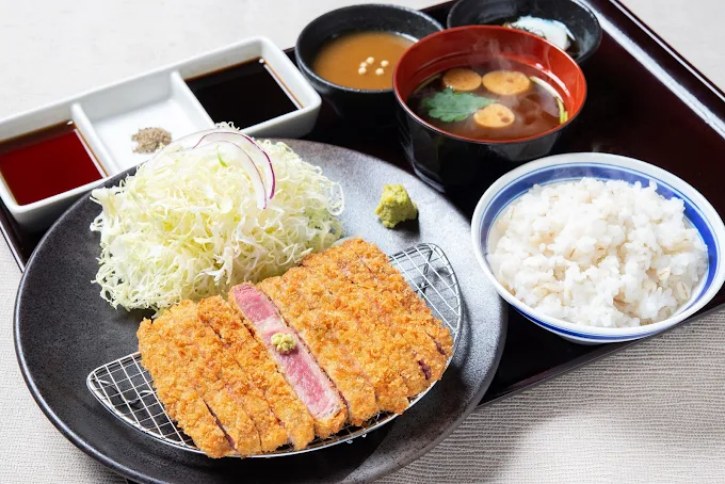
The Sirloin Gyukatsu Zen is their most popular set for ¥1,890 to ¥2,290 ($13 to $16) depending on size.
It comes with rice, miso soup, shredded cabbage, and all those different condiments.
The Chuck Tail Flap version costs ¥2,290 to ¥2,690 ($16 to $18) and has more marbling for richer flavor.
If you want to splurge, try the Premium Wagyu Sirloin for ¥4,390 ($30). The marbling creates a buttery texture that melts in your mouth.
Location: Google Maps
8. Ramen at Honke Daiichi-Asahi (Kyoto)
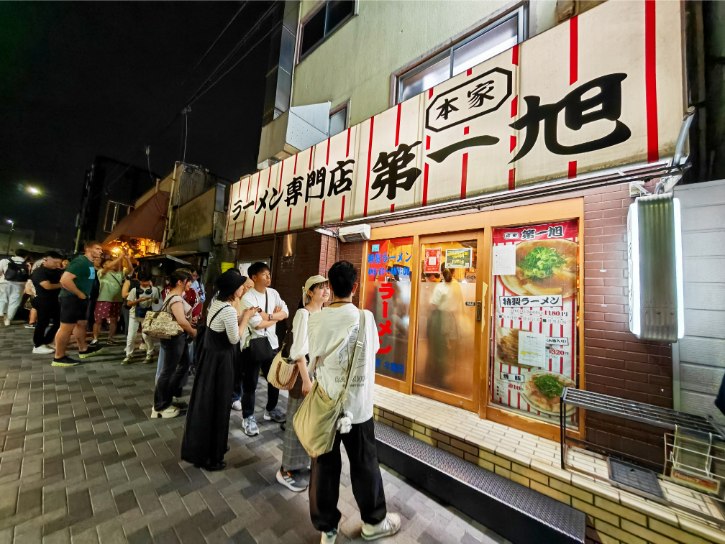
Kyoto-style ramen is different from Tokyo or Osaka versions.
Honke Daiichi-Asahi makes theirs with high-quality Fushimi soy sauce in a rich pork-bone broth that’s full-bodied but not greasy.
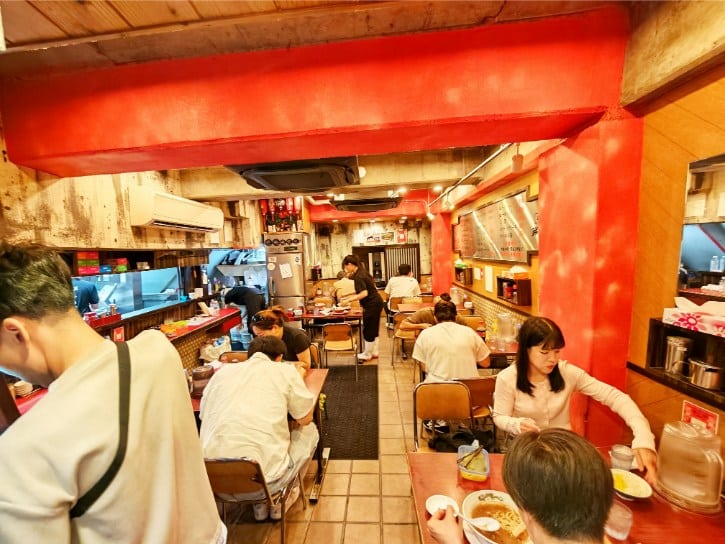
The medium-thick straight noodles have a nice chewy bite that works perfectly with the broth.
House-made chashu pork is tender and flavorful. Fresh Kujo green onions and crunchy bean sprouts add freshness that balances the rich soup.
The broth has deep soy flavor with savory pork notes. It’s bold enough to be satisfying but light enough that you can finish every drop.
The noodles stay firm even at the bottom of the bowl.
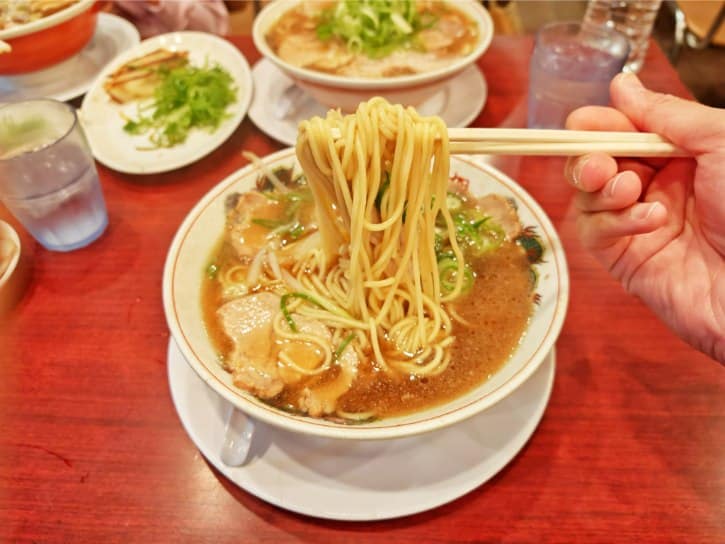
Try the Specialty Ramen Large for ¥1,180 ($8) if you’re very hungry. It comes with plenty of pork and toppings.
The Standard Ramen for ¥980 ($7) is perfect for first-time visitors.
The Menma Ramen adds seasoned bamboo shoots for extra texture and costs ¥1,080 ($7).
Bowls range from ¥830 to ¥1,180 ($6 to $8), making it very affordable for the quality you get.
Location: Google Maps
9. Tendon at Makino Kyoto Teramachi (Kyoto)
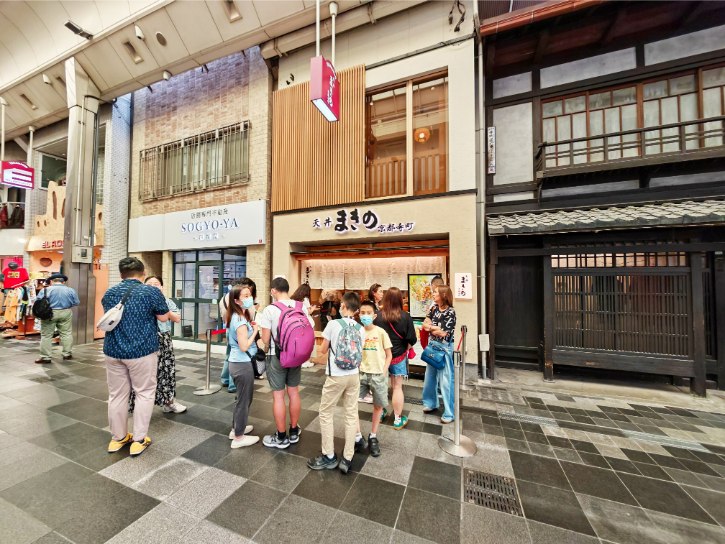
Tendon is a bowl of rice topped with freshly fried tempura and sweet soy-based sauce.
Makino is one of Kyoto’s most popular tendon specialists, located in the busy Teramachi shopping arcade.
The small shop has about 25 seats split between a lively counter downstairs and tables upstairs.
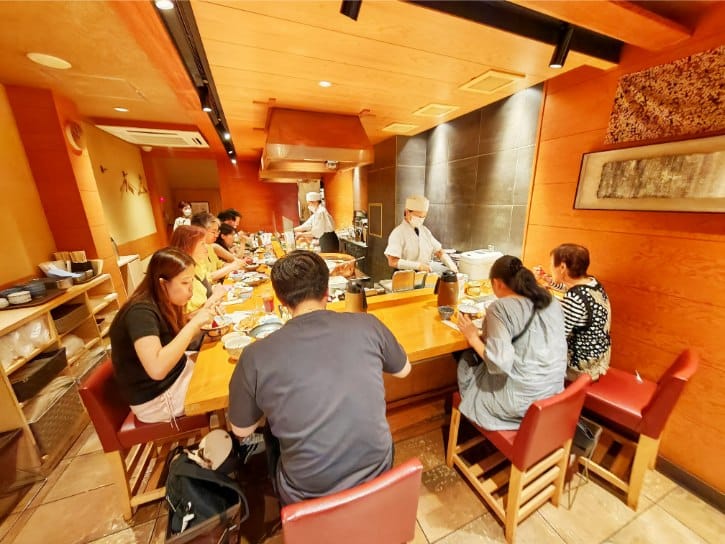
Sitting at the counter lets you watch chefs fry each piece after you order. The sound of frying oil and amazing aromas make it part of the experience.
You need to write your name in the guest book outside and wait for staff to call you. Don’t just walk in.
The tempura has a crisp, light batter that isn’t oily. Shrimp stays juicy, fish is tender, and vegetables taste fresh.
The signature sweet soy glaze gets poured over everything. Ask for extra sauce if you want stronger flavor.
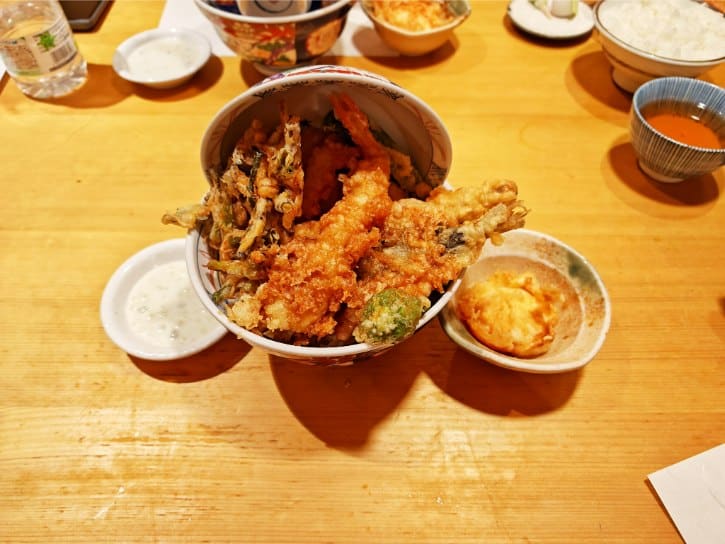
The Shoka Tendon has shrimp, sardine, scabbard fish, eggplant, burdock, and mixed vegetables with squid, green onion, and pepper. You can add soft-boiled egg tempura.
The Shoka Tendon Clam Soup-Set includes the Shoka Tendon plus clam soup, soft-boiled egg tempura, and small sides like three-colored dango and seasonal wasabi tartar for ¥2,700 ($19).
The Tendon A includes shrimp, squid, sand borer fish, sweet potato, seaweed, shishito, and maitake for ¥1,600 to ¥1,800 ($11 to $12).
Bowls cost ¥1,600 to ¥2,400 ($11 to $16). Sets with soup and sides run ¥2,400 to ¥2,700 ($16 to $19).
Location: Google Maps
10. Miso Ramen at Kyoto Engine Ramen (Kyoto)
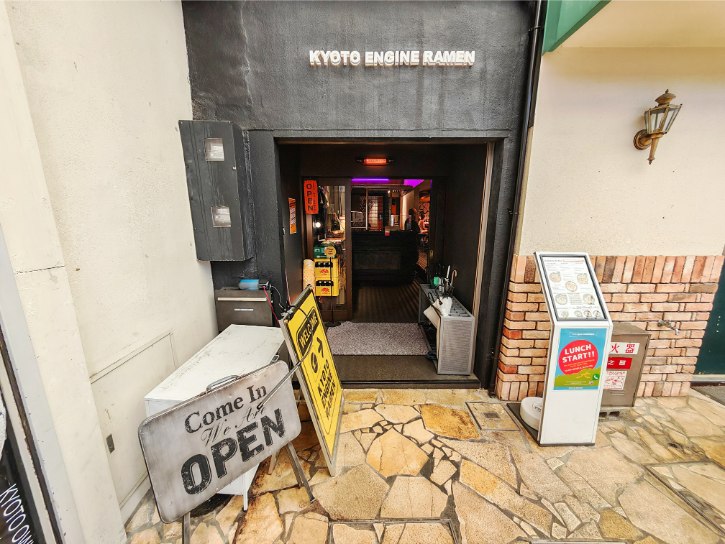
Kyoto Engine Ramen focuses entirely on miso ramen with creative twists. They offer regular, vegan, and even gluten-free options with rice noodles for an extra ¥200.
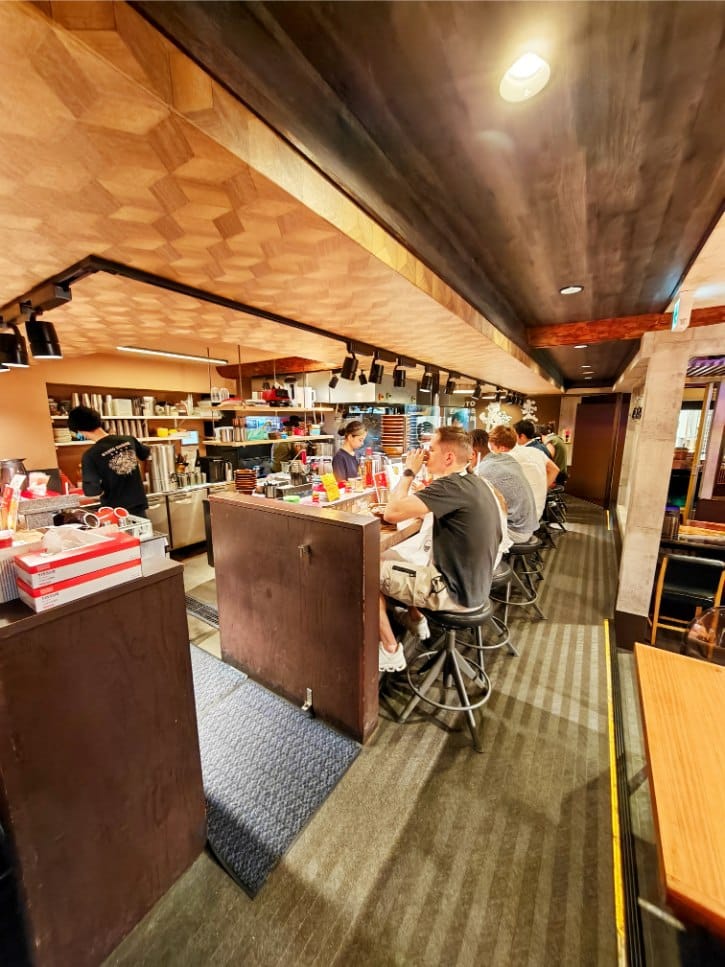
The Kyoto Zesty Ramen is their signature with rich spicy miso broth, soy cream soup base, and daikon.
The heat is balanced and not overwhelming. It comes topped with your choice of pork or chicken chashu, sesame, mushrooms, and lots of green onion.

The Genuine Miso Ramen is lighter at ¥1,400 ($10) with miso sauce, soy cream soup, and chashu. Wood-ear mushrooms, corn, and green onions complete it.
The Genuine Miso ENGINE Ramen costs ¥1,900 ($13) and adds premium toppings like buckwheat seeds and shiso for extra crunch and aroma.
Regular ramen runs ¥1,400 to ¥1,900 ($10 to $13). The vegan options are ¥1,800 ($12).
Location: Google Maps
11. Sushi at Musashi (Kyoto)
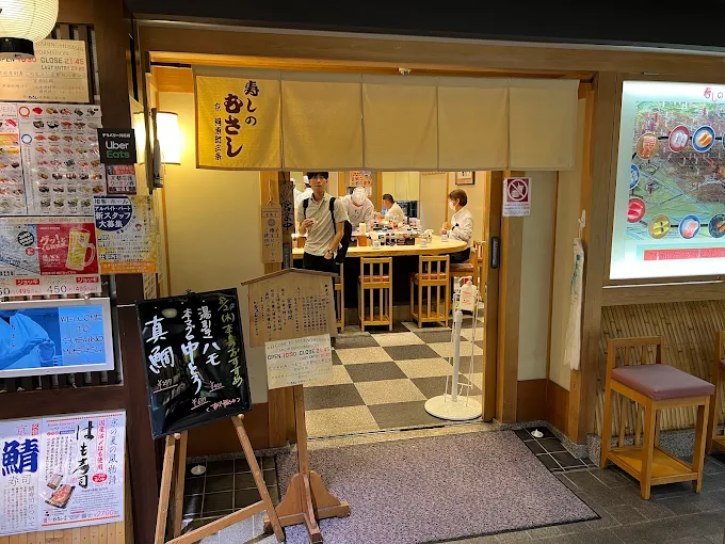
Sushi no Musashi is a conveyor-belt sushi restaurant right inside JR Kyoto Station near the Hachijo entrance. It’s perfect if you want good sushi before catching a train.
This long-running Kyoto chain keeps sushi affordable while maintaining quality.
Over 50 different kinds pass by daily, from classic tuna and salmon to seasonal specialties and unique types like roasted beef sushi or even horse meat sushi.
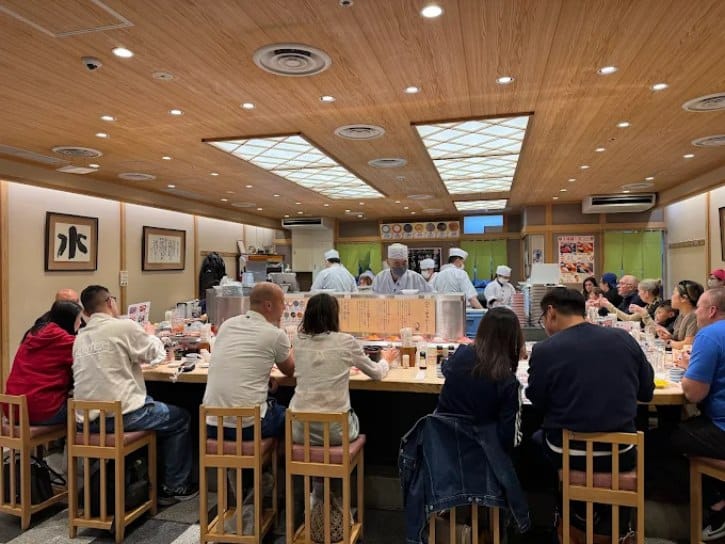
You sit at the counter, watch chefs prepare sushi, and grab plates as they come by. You can also order directly if you don’t see what you want.
The raw shrimp is sweet and delicate, often described as melt-in-your-mouth.
Chutoro premium tuna belly is rich and buttery. Negitoro minced tuna with green onion is creamy with a slight crunch.
The tamago sweet egg omelet is fluffy and comforting between seafood plates.
Standard plates cost about ¥146 ($1) each. Premium plates are around ¥346 ($2.50).
Expect to spend ¥1,500 to ¥2,500 ($10 to $18) per person, which is excellent value for the quality and convenience.
Location: Google Maps
12. Street Food at Nishiki Market (Kyoto)
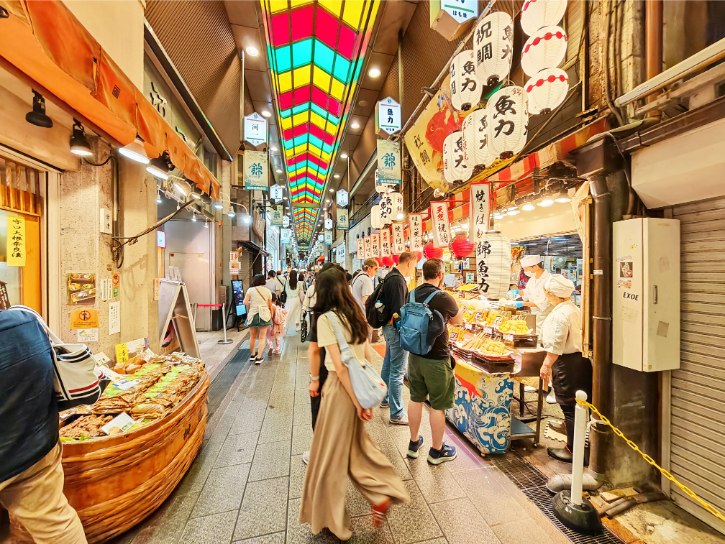
Nishiki Market is over 400 years old and called Kyoto’s Kitchen.
This 5-block stretch has more than 100 stalls packed with everything from fresh seafood to Kyoto vegetables, pickles, tofu, sweets, and tea.
The market is designed for snacking. Most foods are bite-sized and easy to eat while standing, so you can try many different things in one visit.
Many stalls prepare food right there, so you see it grilled, fried, or rolled fresh.
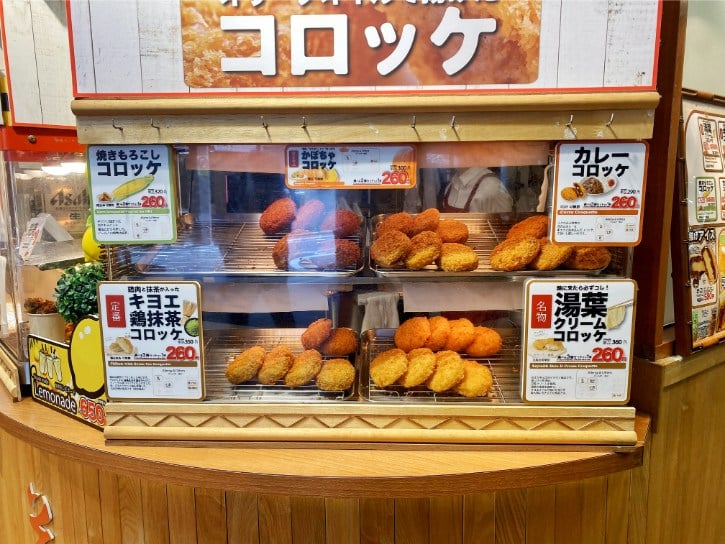
The Yuba Cream Croquette from Hanayori Kiyoe has a golden shell filled with creamy soy milk and tofu skin. It’s crispy outside and smooth inside.

The Soy Milk Donuts from Konna Monja are bite-sized, lightly sweet, and perfect for snacking while you walk.
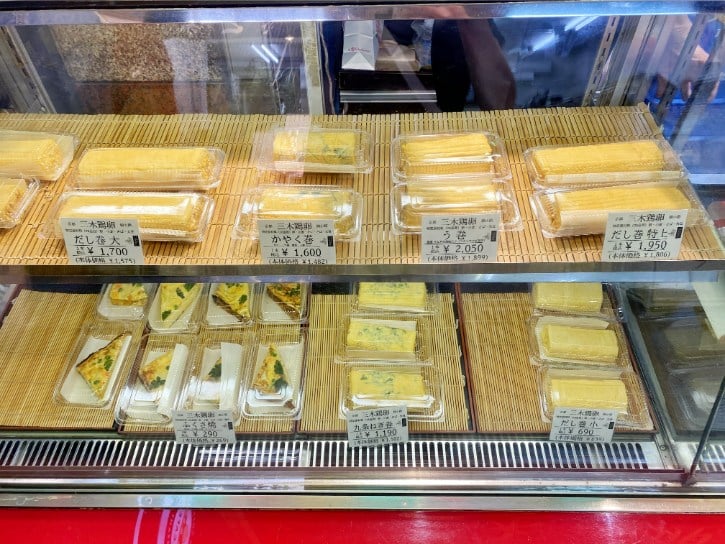
Dashimaki Tamago rolled omelet from Miki Keiran is flavored with dashi broth. It’s soft, juicy, and slightly sweet, served hot on skewers.
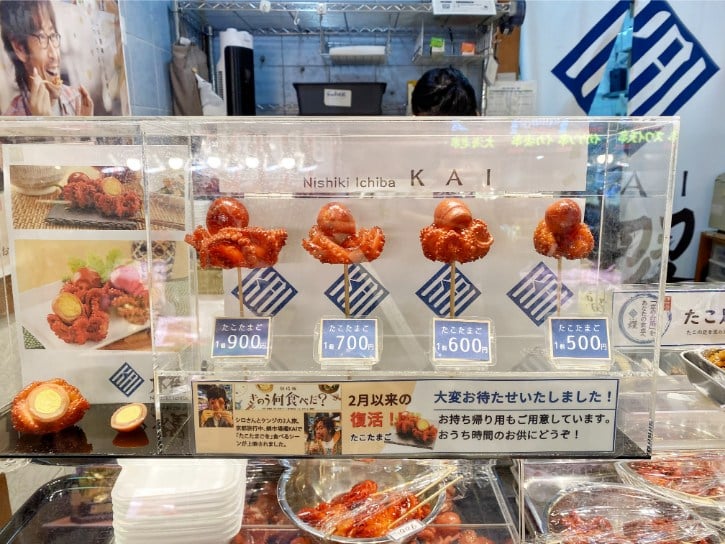
Tako Tamago from Kai is baby octopus with a quail egg stuffed inside its head, simmered in sweet soy glaze.
The grilled eel from Ajisai no Toyo has smoky, crispy skin and tender meat brushed with sweet soy sauce that caramelizes over the grill.
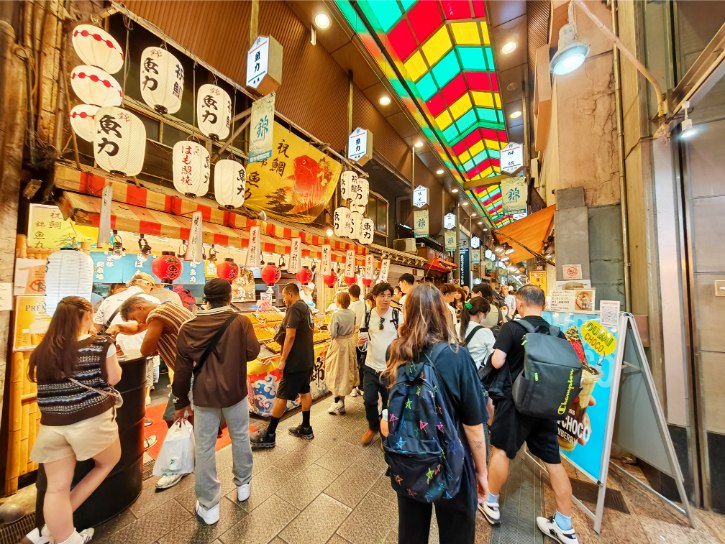
Sea bream skewers from Uoriki are grilled with sauce or deep-fried for a light, melt-in-your-mouth bite.
Most snacks cost ¥300 to ¥600 ($2 to $4) each. Plan about ¥1,500 to ¥2,500 ($10 to $17) per person to try 4 to 6 different foods and a drink.
Heavier dishes like grilled eel run ¥2,000 to ¥3,000 ($14 to $20).
The variety, freshness, and unique flavors make Nishiki Market essential for understanding Kyoto’s food culture.
You’ll taste things here that you won’t find anywhere else, and the lively atmosphere makes it as much about the experience as the food.
Location: Google Maps

